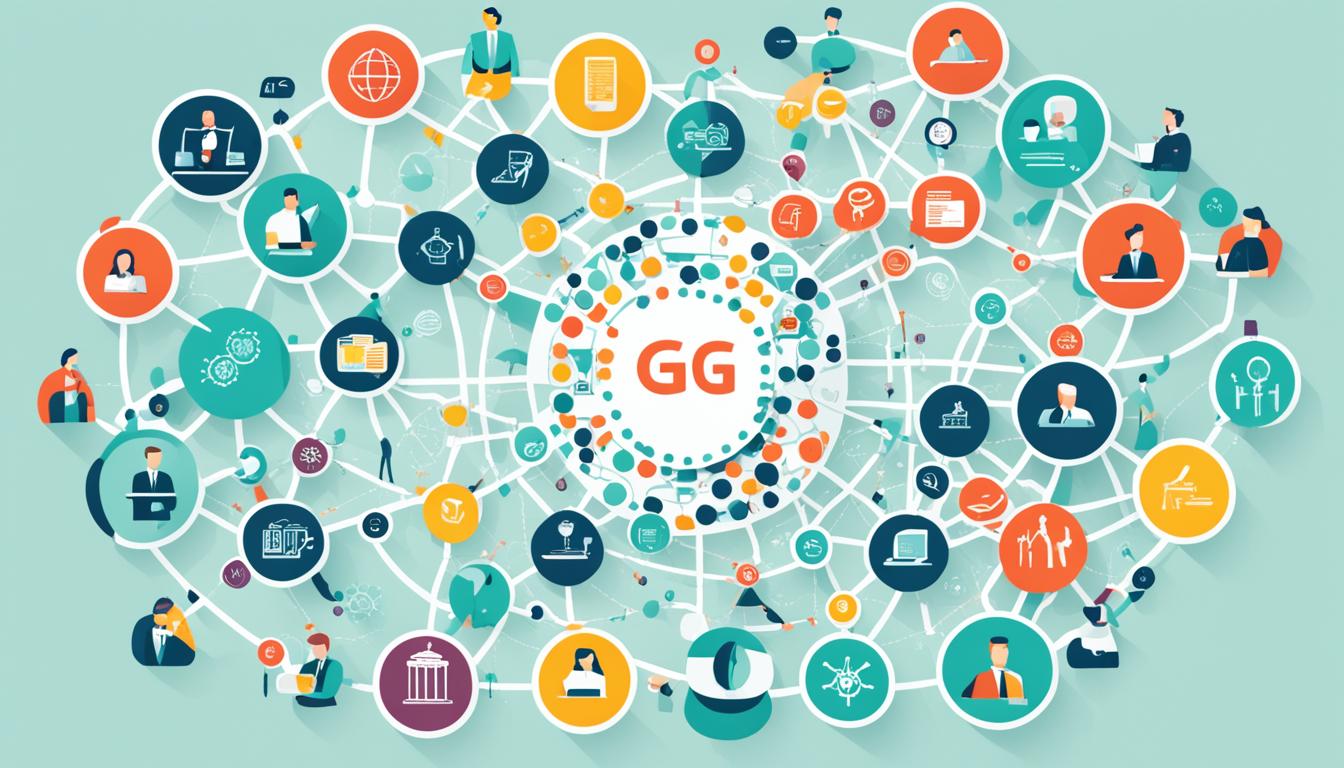Last Updated on December 9, 2025
The gig economy is transforming traditional businesses, offering flexible work trends that help organizations scale efficiently. A report from the McKinsey Global Institute shows that up to 162 million people in Europe and the United States engage in independent work. This trend is set to grow, with the World Economic Forum predicting over 50% of the global workforce in the gig economy by 2025.
This shift in labor dynamics underscores the need for businesses to grasp gig economy trends. Platforms like Upwork and Fiverr connect a wide range of talent, from young millennials to seasoned retirees. This diversity supports a rapidly evolving workplace, allowing companies to cut costs and adapt quickly to market changes.
Key Insights
- The gig economy comprises a large and diverse workforce, enabling businesses to tap into global talent.
- Companies can achieve significant cost savings by hiring gig workers over full-time employees.
- Flexibility and scalability are critical advantages offered by the gig economy for small businesses.
- Understanding the legal and compliance implications of hiring gig workers is essential.
- The rise of digital platforms facilitates connections between businesses and top-tier independent contractors.
- Integration of gig workers requires effective communication and a supportive culture to maximize productivity.
Understanding the Gig Economy
The gig economy is a realm of flexible work arrangements, often involving short-term contracts or freelance roles. This shift allows for independence and control over your schedule. Yet, it also brings challenges in terms of job security and benefits. By delving into gig economy statistics and independent contractor trends, we gain insights into this evolving workforce model.
Definition and Characteristics
The gig economy marks a significant shift away from traditional employment structures. It encompasses roles like rideshare drivers, freelance designers, and consultants. By 2023, nearly 64 million Americans, or about 38% of the U.S. workforce, were involved in freelance or gig work. This setup offers unique benefits:
- Flexibility: Workers have control over their work hours and locations.
- Diverse Opportunities: There’s a broad spectrum of roles that allow individuals to utilize their skills effectively.
- Income Variability: Earnings can fluctuate with demand and workload.
Historical Context and Evolution
Gig work has its roots in history but has seen significant growth with technological advancements. Digital platforms like Upwork, Uber, and Fiverr have transformed how we connect with employers, making freelance opportunities more accessible globally. According to Upwork, 79% of gig workers report higher satisfaction levels than those in traditional employment, with 40% optimistic about future growth. This highlights the gig economy’s popularity and its potential for further expansion.
The Current Gig Economy Landscape
The gig economy has revolutionized work structures, propelled by technological progress and evolving workforce patterns. It has led to a significant shift, with many choosing project-based work over traditional employment. Gig economy statistics show that 36% of the U.S. workforce now engages in gig roles, reflecting a preference for flexibility to balance personal and professional lives.
Statistics and Demographics
Studies reveal that 64 million Americans are freelancers or gig workers, accounting for nearly 38% of the workforce. Their contributions to the economy total about $1.27 trillion. However, gig employment often lacks traditional job security, presenting challenges such as:
- Lack of benefits like health insurance and retirement plans.
- Less predictable income, which complicates financial planning.
- Pressure from the competitive nature of gig work that affects earnings.
Remote work statistics also highlight the trend, showing businesses increasingly turning to gig workers for flexibility. In fields like technology and creative arts, companies benefit from accessing specialized skills through short-term contracts, leading to increased productivity.
Impact of the COVID-19 Pandemic
The COVID-19 pandemic accelerated the growth of the gig economy, as people sought alternative income sources during economic uncertainty. It spurred the adoption of remote work and on-demand services, creating an environment conducive to gig work. Businesses quickly adapted to digital platforms, leading to:
- A rise in hybrid work models that blend traditional employment and gig work.
- A shift in worker preferences towards flexibility and independence.
- Increased reliance on technology to facilitate remote working arrangements.

Emerging trends suggest the gig economy may continue to grow, affecting both businesses and individuals. As workers increasingly favor flexibility, employers are adapting to these changes in workforce behavior.
Gig Economy Trends
The gig economy is undergoing rapid evolution, showcasing significant shifts in workforce dynamics. More professionals are opting for gig work for its flexibility and autonomy. This trend mirrors a broader shift in how individuals view their careers and sources of income.
Growth Projections and Market Insights
By 2027, over 50% of the U.S. workforce is set to engage with the gig economy. Already, 40% of U.S. workers earn a substantial part of their income through gig work. The rise of remote work is driving businesses to offer more flexible work arrangements.
Shifts in Workforce Preferences
Today’s workers prioritize flexibility above all else. A remarkable 77% of Gen Z workers look for work-life balance in their jobs. The gig economy meets this need, allowing workers to control their schedules and enjoy more personal freedom. Companies are starting to adjust to these evolving work trends.
Emerging technologies like AI are transforming the gig economy. About 35% of companies now use AI, with 42% planning to adopt it soon. This technology boosts collaboration and efficiency among gig workers. As the gig economy grows, ensuring stability and fair working conditions becomes a pressing issue for policymakers to protect the welfare of independent workers.
Benefits of the Gig Economy for Businesses
The gig economy brings distinct advantages for businesses, enhancing operational efficiency significantly. As this landscape changes, grasping these benefits is crucial for optimizing outcomes. Companies can see notable cost savings and enjoy increased flexibility to meet market demands.
Cost Savings and Reduced Overhead
The gig economy’s core benefit lies in its cost-saving potential. By engaging independent contractors, businesses cut down on overhead costs linked to employee benefits and long-term commitments. This approach enables strategic resource allocation, focusing on projects without the financial strain of a large workforce. Platforms like Fiverr and Upwork have simplified hiring freelancers, allowing for swift adjustments in staffing as needed.
Flexibility and Scalability
Flexibility is a paramount advantage in the gig economy. Businesses can adjust their labor needs swiftly in response to market fluctuations, avoiding the lengthy hiring processes of traditional methods. Workers gain independence, choosing when and how they work, which aligns with the modern workforce’s desire for varied roles. Adopting gig economy trends equips your company with an agile operational model, keeping you competitive and responsive.
Adapting to this new framework involves investing in technology solutions alongside embracing the gig economy. This combination offers valuable insights and boosts productivity.
Challenges of the Gig Economy
The gig economy has reshaped modern work, offering new chances and flexibility. However, this change brings challenges that you, as a business owner or gig worker, must consider. It’s crucial to grasp these challenges to make informed choices in this evolving field.
Job Security and Employee Well-Being
Independent contractor trends have led to increased job insecurity for many. Gig workers often face unpredictable earnings and lack benefits like health insurance or retirement plans. Recent gig economy statistics show that about 19% of gig workers have gone hungry due to financial struggles. This instability can negatively affect their well-being, causing stress and uncertainty.
Management and Compliance Issues
For businesses, managing gig workers brings challenges in compliance and regulation. Gig economy statistics highlight ongoing debates over worker classification, affecting labor rights, taxes, and duties. Employers must avoid misclassification risks that could lead to legal issues, making business strategies more complex. With one in six American workers now in nontraditional jobs, ensuring compliance with laws is crucial.
How Small Businesses Can Leverage the Gig Economy
Embracing gig economy trends can offer your small business remarkable advantages. The freelance market analysis reveals that many companies find great value in tapping into the diverse skill sets gig workers bring. By outsourcing specific tasks, you can maintain efficiency while accommodating your business’s unique demands.
Identifying Tasks Suitable for Gig Workers
Your first step involves pinpointing which tasks could benefit from gig workers. Consider roles that are:
- Project-based, allowing for focused efforts on short timelines.
- Seasonal, helping you manage fluctuating demands throughout the year.
- Specialized consultations, where specific expertise is required temporarily.
Tasks like graphic design, content creation, and digital marketing can be efficiently handled by freelancers. This enhances your project outcomes without the overhead associated with full-time hires.
Using Gig Platforms Effectively
Platforms like Upwork, Fiverr, and PeopleperHour simplify the hiring process for small businesses. With these platforms, you gain access to:
- A vast pool of talent across various industries.
- Flexibility to scale your workforce according to project needs.
- Cost efficiency through hourly or per-project payment structures.
Establishing best practices in managing gig workers is essential. Clear communication, appropriate onboarding, and ongoing feedback are critical to achieving successful outcomes when incorporating gig workers. By effectively harnessing the gig economy, your business can innovate and respond quickly to market demands.

The Impact on Traditional Business Models
The gig economy is reshaping how companies approach hiring. It’s vital to grasp the implications for your operations. Changes in hiring strategies are a key aspect of this trend.
Shifts in Hiring Strategies
Businesses are increasingly eschewing traditional full-time employment. Gig work’s flexibility aligns with current market needs. Consider these points:
- Increased reliance on short-term contracts for specific projects.
- Flexible work trends allow businesses to scale their workforce based on immediate needs.
- Utilizing gig platforms like Uber and TaskRabbit helps streamline operations.
- Outsourcing tasks can reduce overhead costs, making it a financially attractive option.
Emerging Business Structures
Exploring gig economy trends reveals evolving business models. Companies are adapting to include gig workers. Key points to note include:
- A decentralized workforce creates opportunities for broader talent acquisition globally.
- Flexible working conditions can help attract independent contractors who prefer autonomy.
- Technological tools facilitate collaboration with remote gig workers, enhancing productivity.
- Businesses must implement strategies to manage a mix of gig and full-time employees effectively.
Independent Contractor Trends and Their Implications
The gig economy has seen remarkable growth, leading to significant independent contractor trends that reshape the workforce landscape. More individuals are choosing freelance work, which brings new legal and tax challenges for businesses. It’s crucial for both companies and gig workers to grasp these trends.
Legal and Tax Considerations
Independent contractors face a complex environment with legal and tax obligations. Businesses must ensure they classify workers correctly to avoid hefty penalties. Gig economy statistics highlight the need for knowledge in areas such as:
- Tax withholding responsibilities
- Health benefit requirements
- Compliance with local and federal regulations
- Liability issues in contractor agreements
Knowing these areas is vital, as nearly 75% of hiring managers see online platforms as key to staying competitive. This knowledge helps reduce risks in managing contractors.
The Future of Contractor Relationships
The future of independent work is heading towards more supportive and structured relationships. Companies are realizing the value of investing in their freelance workforce. Providing training and development opportunities boosts contractor job satisfaction. With 51% of businesses planning to increase their use of independent workers, this trend could change traditional workplaces.
As the gig economy grows, it’s expected that nearly 40% of the U.S. workforce may work freelance. The growth of independent contractor trends will lead to new ways of collaboration, highlighting the importance of skilled contractors in various sectors.

Remote Work Statistics and Gig Economy Growth
The relationship between remote work and the gig economy is evolving, showing significant growth and changing dynamics in the workforce. Many professionals now seek freelance opportunities, leading to innovative business practices. This shift boosts productivity and diversifies talent acquisition strategies for employers.
Changing Work Environments
Remote work has led to a preference for freelance roles among many individuals. Recent studies indicate that over two-thirds of full-time gig workers find their freelance careers more secure than traditional jobs. This environment values flexibility and autonomy highly. Companies adapting to these trends can access a broader range of skills and experiences from each freelancer.
Access to Global Talent Pools
Remote work opens up access to global talent pools, allowing companies to hire skilled professionals from diverse backgrounds. Statistics show that platforms like Upwork and Fiverr democratize employment, connecting employers and freelancers across geographical boundaries. About 20% of individuals relied on freelance work to support themselves in 2021. This trend suggests the gig economy will reach a gross volume of $455.2 billion by 2023. The gig economy not only creates jobs but also significantly boosts local economies.

Adapting to the Gig Economy: Strategies for Success
The gig economy is expanding, and businesses must adapt to thrive. It’s crucial to build strong relationships with gig workers. By ensuring open communication, providing feedback, and recognizing their efforts, you can increase loyalty and productivity.
Building Relationships with Gig Workers
Strong connections with freelance talent lead to better collaboration and project success. Here are some strategies to consider:
- Offer personalized onboarding experiences to help gig workers integrate smoothly into your projects.
- Have regular check-ins to offer feedback and solve any issues that come up.
- Recognize and celebrate the contributions of gig workers to keep them engaged.
Implementing Technology Solutions
Using technology can improve managing your flexible workforce. It streamlines workflows and keeps up with gig economy trends. Consider these tech solutions:
- Use collaboration tools for seamless coordination between teams and gig workers, enhancing efficiency.
- Implement project management platforms to track progress and assign tasks effectively, ensuring everyone is aligned.
- Adopt performance management systems tailored for gig work, maximizing output and quality.

Conclusion
The gig economy is reshaping business operations, offering both opportunities and challenges. To thrive in this evolving market, it’s essential to grasp the dynamics of the gig economy. Currently, the global gig economy generates a staggering $204 billion annually, with forecasts suggesting a 17% increase by 2023. This shift demands new strategies for managing the workforce.
By 2027, gig workers in the U.S. are expected to outnumber those in traditional employment. This underscores the need for businesses to adopt flexible staffing models. Large firms and smaller entities alike can benefit from the flexibility and varied skills gig workers bring. Integrating gig workers helps bridge resource gaps, boosts productivity, and fosters innovation.
Managing the gig economy’s complexities, including legal and job security aspects, is vital for a stable relationship with freelancers. Adopting forward-thinking strategies, like effective management tools and clear communication, is key to success. As you delve into freelance market analysis, focus on building a workforce that’s sustainable and adaptable to economic changes.








